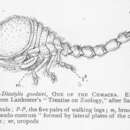en
names in breadcrumbs


Diastylidae is one of the eight most commonly recognised families of crustaceans of the order Cumacea. They are marine creatures especially common around the 30th parallel north.[2]
Diastylidae have a medium to large, free telson, that has not fused with the last pleon segment. The telson usually bears two terminal setae.[3]
Males have generally two pairs of pleopods, though in rare cases they may be rather small or even entirely absent. The flagellum of the second antenna reaches past the pereon.[3]
In females the second antenna is much smaller than the first antenna. In males the third maxilliped and the first four pereiopods almost always have exopods (outer branches). In females they may, in rare cases, be absent from all but the third maxillipeds, and the two first pereiopods.[3]
The interior branch of the uropods are generally made up of two or three segments, but in some rare case may have just one. Members of this family frequently show clear sexual dimorphism.[3]
There are around 285 species,[4] in 24 genera:[5]
Diastylidae is one of the eight most commonly recognised families of crustaceans of the order Cumacea. They are marine creatures especially common around the 30th parallel north.
Diastylidae (Bate, 1856) è una famiglia di crostacei malacostraci appartenenti all'ordine dei Cumacei.[1]
In questa famiglia sono ricompresi 24 generi[2] ai quali appartengono 285 specie[3]:
Diastylidae (Bate, 1856) è una famiglia di crostacei malacostraci appartenenti all'ordine dei Cumacei.
Diastylidae is een familie van kleine kreeftachtigen die behoort tot de orde van de zeekomma's (Cumacea). Het zijn koudwaterdieren die vooral aangetroffen worden ten noorden en ten zuiden van de 30e breedtegraad (Watling & McCann 1997)[2].
Diastylidae zijn zeekomma's die een gemiddeld tot groot, vrij telson bezitten. Het is niet vergroeid met het laatste pleon segment. Het telson draagt meestal twee apicale stekels. De mannetjes bezitten meestal twee paar zwempootjes (pleopoden), soms zijn die vrij klein of zelfs helemaal afwezig. Het flagellum van de tweede antenne reikt tot voorbij het pereon. Bij vrouwtjes is de tweede antenne veel kleiner dan de eerste antenne. De derde maxillipede en de eerste vier pereopoden bezitten bij mannetje bijna altijd een exopodiet (buitenste vertakking). Bij vrouwtjes beperkt zich dit tot de derde maxillipede—bij uitzondering zijn ze zelfs helemaal afwezig—en de twee eerste pereopoden. De endopodiet (binnenste tak) van de uropode bestaat meestal uit drie, soms uit twee, en zelden uit één segmentje.
Leden van deze familie vertonen vaak een duidelijk seksueel dimorfisme. (Jones, 1976)[3].
Vijf soorten uit de familie Diastylidae komen voor in het Belgische deel van de Noordzee: Diastylis bradyi, D. laevis, D. lucifera, D. rathkei en D. rugosa[4].
De Diastylidae zijn een middelgrote familie met 23 genera (geslachten) en 323 soorten.
Volgende genera werden beschreven (Watling & Gerken, 2003)[5]:
Diastylidae is een familie van kleine kreeftachtigen die behoort tot de orde van de zeekomma's (Cumacea). Het zijn koudwaterdieren die vooral aangetroffen worden ten noorden en ten zuiden van de 30e breedtegraad (Watling & McCann 1997).
Diastylidae (лат.) — семейство морских кумовых раков из класса высших раков (Malacostraca). Около 300 видов[2].
Небольшие ракообразные, внешним видом тела напоминающие головастиков: покрытая панцирем вздутая головогрудь и грудной отдел (покрыты общим панцирем карапаксом) укрупнены и контрастируют с более тонким брюшком (плеоном), заканчивающимся хвостовой вилкой. Анальная лопасть (тельсон) развита, свободная, цилиндрической или округлённой формы, суживается к концу, несёт как правило 2 апикальных шипика (иногда они отсутствуют, или их число равно 1 или 3). Антенны 1 с маленьким добавочным жгутиком. Антенны 2 самок состоят из 3 или 4 сегментов (конечный членик короткий). Уроподы (удлинённые конечности шестого сегмента) имеют 1-, 2- или 3-члениковый эндоподит [3][4]. Члены этого семейства семьи часто демонстрируют явный половой диморфизм[5].
Насчитывает около 300 видов и 24 рода. Семейство было впервые выделено в 1856 году британским зоологом Чарльзом Спенсом Бейтом (Charles Spence Bate; 1819—1889). В российских водах Японского моря встречаются представители 7 родов и более 10 видов[3].
Diastylidae (лат.) — семейство морских кумовых раков из класса высших раков (Malacostraca). Около 300 видов.